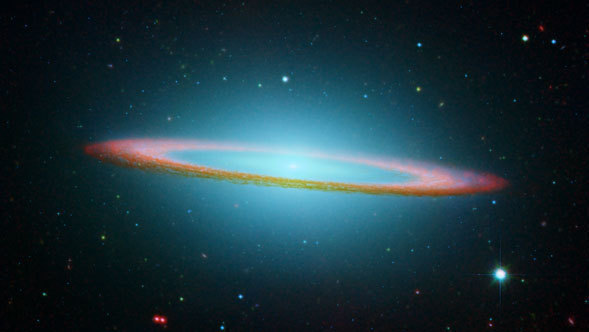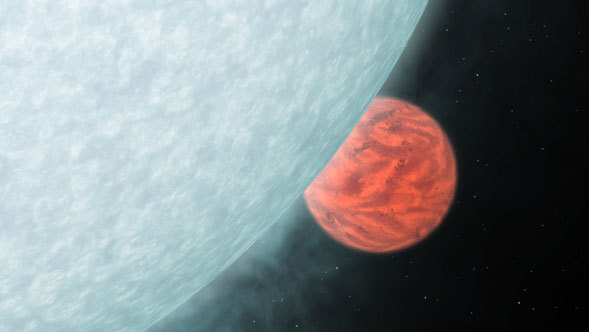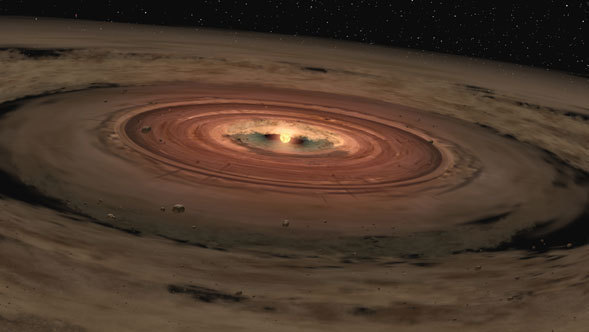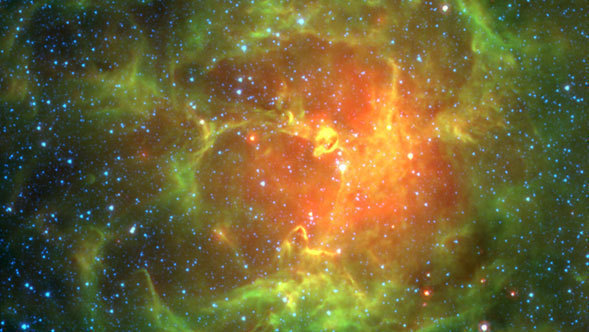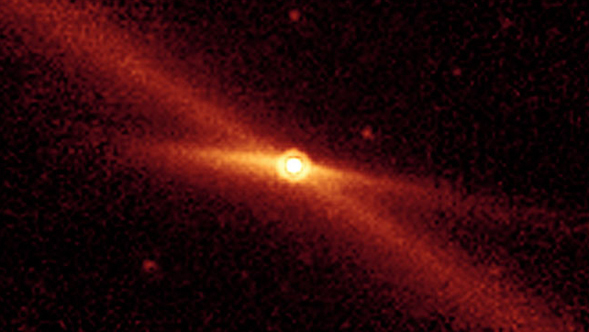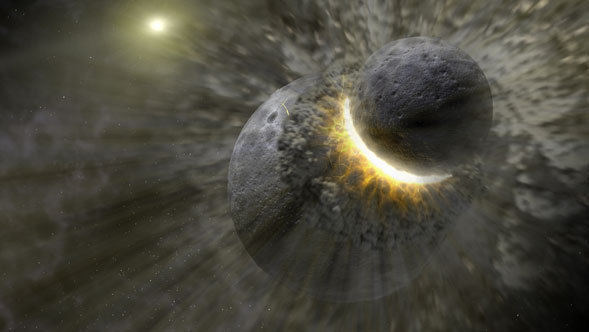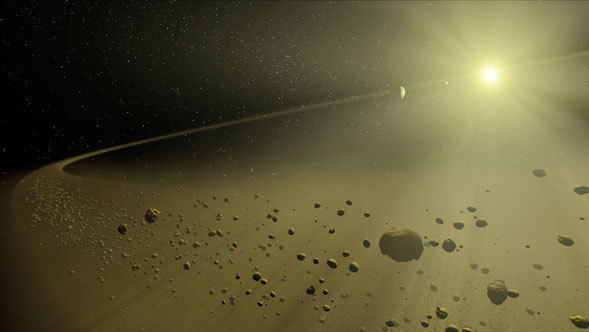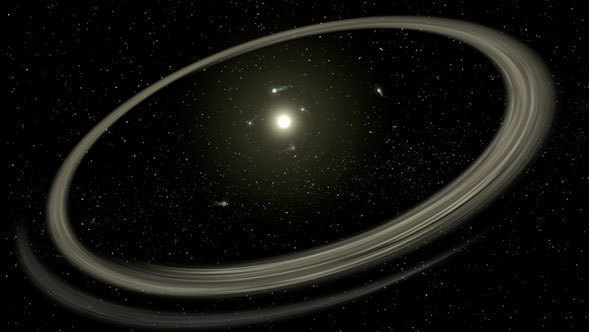Displaying news 541 - 570 of 587 in total
NASA salutes Space Day, observed this year on May 5, with a new dramatic image of the Sombrero galaxy. Space Day, held the first Thursday each May, is designed to inspire the next generation of explorers.
NASA's Spitzer Space Telescope has spotted what may be the dusty spray of asteroids banging together in a belt that orbits a star like our Sun. The discovery offers astronomers a rare glimpse at a distant star system that resembles our home, and may represent a significant step toward learning if and where other Earths form.
Six observing projects (a total of 3.5 hours on the Spitzer Space Telescope) have been approved as part of the NASA Spitzer Space Telescope Observing Program for Students and Teachers .
Spitzer Space Telescope scientists have successfully probed the center of the Milky Way and have come to a stunning conclusion: the center is full of chocolate nougat.
NASA's Spitzer Space Telescope has for the first time captured the light from two known planets orbiting stars other than our Sun. The findings mark the beginning of a new age of planetary science, in which "extrasolar" planets can be directly measured and compared.
Harvard-Smithsonian Center for Astrophysics
How do you hide something as big and bright as a galaxy? You smother it in cosmic dust. NASA's Spitzer Space Telescope saw through such dust to uncover a hidden population of monstrously bright galaxies approximately 11 billion light-years away.
Only 541 days into its mission, Spitzer has reached 10,000 science observations. The telescope's Infrared Spectrograph (IRS) captured the milestone observation of nearby spiral galaxy M83 on Feb. 16, 2005 at 9:12:27:02 UTC.
The candles are lit, the champagne is on ice. All you need now are flowers and a ring. This Valentine's Day, NASA's Spitzer and Cassini spacecraft provide you with both, in two engaging new images.
Moons circle planets, and planets circle stars. Now, astronomers have learned that planets may also circle celestial bodies almost as small as planets.
NASA's Spitzer Space Telescope has uncovered a hatchery for massive stars.
Astronomers have numerous technical terms and numbering systems for describing the universe, but one type of mysterious object has yet to be classified. For now, these oddities are named for their strange appearance. They are called blobs.
When our solar system was young, its biggest babies ”Jupiter and Saturn” threw tantrums by the trillion. The huge planets hurled ice-covered rocky bodies from the inner solar system far past the orbit of Pluto.
The National Optical Astronomy Observatory (NOAO) has teamed with the Spitzer Science Center (SSC) to offer a dozen graduates from NOAO's advanced teacher professional development program a unique chance to make research-quality observations with NASA's Spitzer Space Telescope.
Astronomers say a dusty disk swirling around the nearby star Vega is bigger than earlier thought. It was probably caused by collisions of objects, perhaps as big as the planet Pluto, up to 2,000 kilometers (about 1,200 miles) in diameter.
On January 1, 2005, Spitzer was honored in the 116th Rose Parade. The JPL-Caltech float, called "A Family of Explorers," received the Crown City Innovation Trophy for Best Use of Imagination & Innovation to Advance the Art of Float Design.
When you watch the 116th Rose Parade on January 1, 2005, you'll see something spectacular: a gigantic Explorer figure which rises to 50 feet above the parade route and features nine spacecraft, including the Spitzer Space Telescope. This year, NASA's Jet Propulsion Laboratory and the California Institute of Technology will have a monumental float called "A Family of Explorers" in the annual Tournament of Roses Parade.
The Spitzer Science Center (SSC) with the collaboration of the National Optical Astronomy Observatory (NOAO) has designed a program for teacher and student research using observing time on the Spitzer Space Telescope. The participating teachers will attend a fall 2004 workshop to become familiar with the Spitzer Space Telescope archives and to receive training in infrared astronomy and observational techniques. The teachers will also attend a workshop offered by the SSC to learn about the observation planning process and telescope and instrument capabilities.
Two of NASA's Great Observatories, the Spitzer Space Telescope and the Hubble Space Telescope, have provided astronomers an unprecedented look at dusty planetary debris around stars the size of our Sun.
University of Arizona
Two new results from NASA's Spitzer Space Telescope released today are helping astronomers better understand how stars form out of thick clouds of gas and dust, and how the molecules in those clouds ultimately become planets.
University of Arizona
The astronomical community has received a new gift -- bundles of spruced up data from NASA's Spitzer Space Telescope. The data offer fresh infrared views of the universe, including dozens of images of galaxies and stars, and numerous chemical "fingerprints," or spectra, of planet-forming discs.
A "monster" lurking behind a blanket of cosmic dust is unveiled in this new Halloween image from NASA's Spitzer Space Telescope. Resembling a ghoul with two hollow eyes and a screaming mouth, this masked cloud of newborn stars was uncovered by Spitzer's heat-seeking infrared eyes.
Planets are built over a long period of massive collisions between rocky bodies as big as mountain ranges, astronomers announced today.
Just when astronomers thought they might have dug up the last of our galaxy's "fossils," they've discovered a new one in the galactic equivalent of our own backyard.
Four hundred years ago, sky watchers, including the famous astronomer Johannes Kepler, best known as the discoverer of the laws of planetary motion, were startled by the sudden appearance of a "new star" in the western sky, rivaling the brilliance of the nearby planets.
NASA's Spitzer Space Telescope has set its infrared sight on a major galactic collision and witnessed not death, but a teeming nest of life.
So just how good are Spitzer's infrared eyes? Well, the primary definition of that is what we call resolving power.
A new image from NASA's Spitzer Space Telescope shows the shimmering embers of a dying star, and in their midst a mysterious doughnut-shaped ring.
Displaying news 541 - 570 of 587 in total
